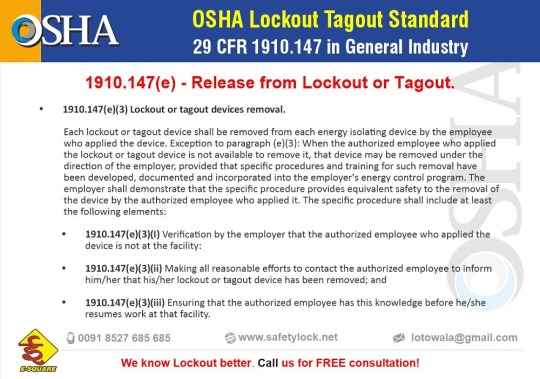#OSHAStandard
Explore tagged Tumblr posts
Text
OSHA Lockout Tagout Standard: Application of Control 1910.147(d)(4)

The next element of the sequence is:
Lockout Tagout application: The isolating device must be locked and tagged out by the authorized employee using individual Locks and Tags. These Locks & Tags must be affixed to each energy isolating device to hold it in a safe or off position and physically prevent its operation. Tagout devices must be affixed in a manner that it indicates the movement of the isolating device from the safe or off position is prohibited. Moreover, when the Tagout device is used along with the Lockout device, capable of being locked out, the tag so attached must be fastened at the same point at which the lock would have been attached. Although the Tag is supposed to be attached to the equipment along with the isolating device, in cases where the tag cannot be directly attached to the energy isolating device, it shall be located as close as safely possible to the device. Making sure that it is easily visible to the employee working on the machine, or around the machine, to avoid any inadvertent energization. Check OSHA Guidelines - https://www.safetylock.net/learn-lockout-tagout/osha-documentation/
#LockoutTagout#OSHA#LockoutDevice#TagoutDevice#LockoutTagoutDevices#OSHAGuidelines#LockoutTagoutManufacturer#LOTODevices#Safety#OSHAStandard#LOTO#WorkplaceSafety#SafetyTips#ESquare#ESquareAlliance
2 notes
·
View notes
Text
OSHA Standard 29 CFR 1910.147 - Definition of Hot Tap and & Normal Production Operations

Hot Tap:
As discussed in our previous post, OSHA standard 29 CFR 1910.147(a)(2) does not apply to Hot Tap and Normal Production Operations.
Hot tapping, or pressure tapping, is the method of making a connection to the existing piping or pressure vessels without interrupting the servicing for air, gas, water, steam, and petrochemical distribution systems. This means that a pipe can continue to be in operation while maintenance or modifications are being done to it. Only if the employer demonstrates that
· continuity of service is essential
· shutdown of the system is impractical
· documented procedures are followed, and special equipment is used which will provide proven effective protection for employees.
Normal Production Operation:
Certain tasks such as minor and repetitive adjustments are considered normal production operations when they are integral to the use of the equipment, and when they do not increase the risk of injury to employees.
So, OSHA Standard, 29 CFR 1910.147 (a)(2) does not apply to Hot tap and Normal Production Operations only when the employees working on it are considered to be SAFE.
Check OSHA Guidelines - https://www.safetylock.net/learn-lockout-tagout/osha-29-cfr-1910-147-explained/
#OSHA#LockoutTagout#HotTap#LockoutDevices#LockoutTagoutDevices#LockoutTagoutOSHA#OSHAGuidelines#LOTO#OSHAStandard#OSHARegulations#OSHALockoutTagout#LockoutTagoutProcedure#ESquare#ESquareAlliance
0 notes
Text
What Is The OSHA Rule For Portable Toilets in Orlando? 🛠️🚽
Are you meeting OSHA standards on your Orlando job site? Our latest blog explains what you need to know about portable toilet requirements, including the number of units, cleaning schedules, and compliance tips.
Read more 👉 What Is The OSHA Rule For Portable Toilets in Orlando? Check our GMB update 👉 https://posts.gle/6SaiPX
Orlando Porta Potties | PotPro 121 S Orange Ave, Orlando, FL 32801 (689) 268-1167

#OSHARules#PortableToiletsOrlando#ConstructionToilets#JobSiteSanitation#WorkplaceCompliance#OrlandoPortaPotties#RestroomRentalOrlando#OSHAStandards#WorksiteSafety#SanitationRequirements
0 notes
Text
What Is The OSHA Standard For Porta Potties? 🚧🚽
Making sure your job site complies with OSHA sanitation standards is essential. In our blog post, we cover the number of units required, maintenance rules, and how to stay within regulations to keep your team safe.
Read more here 👉 What Is The OSHA Standard For Porta Potties?
Hackney Renters 1201 S Grand Ave, Los Angeles, CA 90015 (888) 596-6032

#OSHAStandards#PortaPottyRental#ConstructionSafety#SanitationRegulations#WorksiteCompliance#PortableToilets#HackneyRenters#HealthAndSafety#JobsiteRequirements#ConstructionSanitation
0 notes
Text

Regulatory Compliance in Commercial Scaffolding
Regulatory compliance in commercial scaffolding involves adhering to safety standards set by authorities like OSHA and local building codes. This includes proper installation, regular inspections, and ensuring worker safety. Compliance ensures structural stability, reduces risks of accidents, and maintains legal requirements, promoting safe construction practices.
0 notes
Text
Arizona's top OSHA-10 training program | ACDC
Learn about OSHA-10 training alternatives in Arizona to ensure you have the necessary safety equipment. Enroll in a globally recognized education program to ensure a safe future.
#TopTrainingProgram#ACDCcertified#SafetyFirst#WorkplaceSafety#OSHACompliance#AZSafetyTraining#ConstructionSafety#SafetyCertification#ACDCprogram#OSHA10Training#ACDCtraining#OSHAStandards#ACDCcertification#SafetyTrainingAZ
0 notes
Text
Tower Climbing Safety Standards and Protocols for WISP Operations

Introduction
In the dynamic landscape of Wireless Internet Service Providers (WISPs), the efficient functioning of networks is reliant on the tireless efforts of tower climbers. These skilled professionals face the unique challenge of scaling heights to install, maintain, and troubleshoot wireless infrastructure. With the inherent risks associated with tower climbing, it is imperative for WISPs to establish and adhere to stringent safety standards and protocols. In this comprehensive discussion, we will delve deeper into U.S. government regulations, compliance necessities, and best practices aimed at safeguarding the well-being of tower climbers in WISP operations.
Government Safety Regulations for Tower Climbers in WISPs
FCC Regulations: The FCC, as the regulatory authority overseeing wireless communications, imposes guidelines to ensure the safety of both workers and the general public. FCC regulations encompass two critical aspects: radiofrequency emissions and structural integrity. Tower climbers must adhere to prescribed emission limits and follow structural guidelines to prevent tower collapses. Compliance with FCC regulations is not only a legal requirement but is instrumental in securing licenses and maintaining the integrity of wireless networks.
OSHA Standards: OSHA, the cornerstone of workplace safety in the U.S., has established specific standards for tower climbing operations. These standards cover a range of safety measures, including fall protection, equipment specifications, and comprehensive training requirements. WISPs are obligated to meet these standards to guarantee a secure working environment for tower climbers and mitigate the risks associated with working at heights.
Compliance and Best Practices for Tower Climbing Safety
Comprehensive Training Programs: Tower climbing demands a unique skill set that extends beyond technical proficiency. WISPs must invest in comprehensive training programs that not only impart technical know-how but also instill a strong emphasis on safety protocols, emergency procedures, and the correct utilization of personal protective equipment (PPE). Certifications such as the Tower Climbing Safety and Rescue Training are instrumental in ensuring climbers are well-prepared for the challenges they may encounter.
Equipment Inspection and Maintenance: Regular and meticulous inspection of climbing equipment is imperative to identifying potential risks. Harnesses, lanyards, helmets, and other safety gear should undergo scrutiny before each use. Prompt replacement of faulty or worn-out equipment is vital to preventing accidents and ensuring the reliability of safety measures.
Fall Protection Systems: Fall protection systems serve as a critical line of defense for tower climbers. WISPs must implement and enforce robust fall protection measures, including certified fall arrest systems, guardrails, and ladder safety devices. These measures not only minimize the risk of falls but also provide climbers with effective protection in the event of an unexpected descent.
Communication Protocols: Effective communication is paramount during tower climbing operations. WISPs should establish standardized communication protocols that minimize the risk of misunderstandings and enable climbers to convey critical information promptly. Clear communication channels with ground personnel, fellow climbers, and relevant stakeholders enhance overall safety and coordination.
Emergency Response Plans: Developing and regularly reviewing emergency response plans specific to tower climbing operations is essential. These plans should outline procedures for responding to injuries, rescuing climbers in distress, and coordinating with emergency services. Regular drills and simulations contribute to the preparedness of all involved parties.
Weather Monitoring: Given the exposure of tower climbers to the elements, WISPs should implement robust weather monitoring protocols. Establishing clear guidelines for suspending climbing activities during adverse weather conditions, such as high winds, thunderstorms, or icy conditions, is crucial to ensuring the safety of climbers.
Documentation and Record-Keeping: Maintaining meticulous records of safety training, equipment inspections, and any incidents that occur during tower climbing operations is integral. These records not only serve as evidence of compliance with regulations but also offer valuable insights for the continuous improvement of safety protocols.
Conclusion
In the realm of WISP operations, where success is measured by connectivity and coverage, ensuring the safety of tower climbers is non-negotiable. By rigorously adhering to government safety regulations, investing in comprehensive training, and implementing best practices, WISPs can fortify the safety of their tower climbers. In an industry that reaches new heights every day, the well-being of those who scale the towers should remain a steadfast priority, reflecting a commitment to both regulatory compliance and the preservation of human life.
#TowerClimbingSafety#WISPOperations#OSHAStandards#FCCRegulations#WirelessInfrastructureSafety#fixedwireless#rural broadband#connectivitysolutions
0 notes
Text

Learn More HSE Technics and Updated Course Structure - OSHA 30 Hours with Green World Group
At Green World Group, we understand the importance of staying up-to-date with the ever-evolving field of health, safety, and environment (HSE). Our revamped OSHA 30 Hours course is designed to equip you with the necessary skills and expertise to navigate the challenges of today's workplace. We are excited to announce that Green World Group is now offering an updated course structure for the OSHA 30 Hours certification, focused on providing you with the latest HSE techniques and knowledge.
Visit Us : www.greenwgroup.org Contact Us : +918089011469 Email : [email protected]
#OSHA30#SafetyTraining#GreenWorldGroup#OccupationalSafety#SafetyEducation#OSHAStandards#WorkplaceSafety#SafetyCompliance#HSETraining#SafetyCertification#SafetyFirst#WorkplaceWellness#SafetyCulture#OSHACompliance#SafetyAwareness#IndustrialSafety#SafetyProcedures#SafetyLeadership#SafetySkills#HealthAndSafety#SafeWorkEnvironment#EmployeeSafety#RiskManagement#SafetyGuidelines#SafetyProfessional#SafetyAtWork#SafetyMeasures#OSHACertification
0 notes
Text
Get Tax Credits for Keeping Employees Safe During COVID-19 #childcareandschoolclosures #COVID19relatedquarantine #eligiblewages #employeeretentioncredits #ERCcalculation #ERCdocumentation #IRSmemo #OSHAstandards #taxcredits #workplacesafetyguidelines
#Business#childcareandschoolclosures#COVID19relatedquarantine#eligiblewages#employeeretentioncredits#ERCcalculation#ERCdocumentation#IRSmemo#OSHAstandards#taxcredits#workplacesafetyguidelines
0 notes
Photo

REJUVENATE DISINFECTANT FOR DAYS. @rejuvenatedisinfectants talk about a multi pack...leaves the surface visibly clean and I like it!! I was so happy this shipment arrived. I had to order so much at one time ftom different places I wasn't sure when what would come. I needed this box to arrive swiftly and it did. I'm getting in formation! Not sure what this virus is but best I can I'm preparing and stocked up! . . . . . #rejuvenate #rejuvenatedisinfectants #oshastandards #osha #disinfect #disinfectant #fightgerms #fightcoronavirus💪#preparedness #nycnailtech #nycnailtechnician #nycnailartist #nailtechnician #licensedprofessional (at Bronx, New York) https://www.instagram.com/p/CBJ9ZBYBXhh/?igshid=1x8mh16uj587t
#rejuvenate#rejuvenatedisinfectants#oshastandards#osha#disinfect#disinfectant#fightgerms#fightcoronavirus💪#preparedness#nycnailtech#nycnailtechnician#nycnailartist#nailtechnician#licensedprofessional
0 notes
Link
International Association of Safety Professionals is a non-profit membership organisation providing training, consultative services, and third-party certifications that validate knowledge, skills and abilities in the area of workplace safety.
0 notes
Text
OSHA Lockout Tagout Standard 1910.147(e) - Lockout or Tagout Devices Removal

Each lockout or tagout device shall be removed from each energy isolating device by the employee who applied the device. But as per the Exception to paragraph (e)(3): If the employee who applied the LOTO device is not available to remove it, that device may be removed under the direction of the employer, provided that specific procedures and training for such removal have been developed, documented and incorporated into the employer's energy control program. The specific procedure shall include at least the following elements: (e)(3)(i) Verification by the employer that the authorized employee who applied the device is not at the facility: (e)(3)(ii) Making all reasonable efforts to contact the authorized employee to inform him/her that his/her lockout or tagout device has been removed; and (e)(3)(iii) Ensuring that the authorized employee has this knowledge before he/she resumes work at that facility. However, the removal of personal Lockout Tagout device by another employee is not possible for the sake of convenience or simply because the authorized person is not available. Check OSHA Guidelines - https://www.safetylock.net/learn-lockout-tagout/osha-documentation/
#LockoutTagout#OSHA#ReleaseLockoutTagout#LockoutTagoutRemoval#LOTORemoval#LockoutTagoutProcedure#Safety#SafetyFirst#OSHAGuidelines#LOTO#OSHAStandard#OSHARegulations#OSHALockoutTagout#LockoutTagoutDevice#LockoutTagoutManufacturer#ESquare
0 notes
Text
OSHA Lockout Tagout Standard 1910.147(e) - Release from Lockout or Tagout

After the maintenance task is complete, the machines are supposed to be reenergized and restored to normal production operation. But, before that reenergization takes place, OSHA’s Lockout Tagout standard requires that, standardized procedures should be followed, to ensure that employees are not subject to an increased potential for injury. Section (e)(1) requires that when the maintenance task is complete, the work area should be examined and thoroughly checked to ensure that all the nonessential items, including guards, left-behind tools, parts, and materials, have been removed, and that the equipment is operationally intact to avoid any mishap. Section (e)(2) requires a check of the work area to ensure that all employees are safely positioned, and the affected employees are notified that the Lockout Tagout devices have been removed, and the machine is safely reenergized. Check OSHA Guidelines - https://www.safetylock.net/learn-lockout-tagout/osha-documentation/
#LockoutTagout#OSHA#LockoutDevice#LockoutTagoutDevices#OSHAGuidelines#LOTODevices#Safety#OSHAStandard#LOTO#WorkplaceSafety#SafetyTips#ESquare#ESquareAlliance
0 notes
Text
OSHA Lockout Tagout Standard: Application of Control 1910.147(d) (5) (6)
Stored Energy: After applying the Lockout Locks and tags, check for the stored or residual energies. Any residual energy ignored by any chance can be a potential danger, leading to accidents and fatalities. Therefore, it shall be relieved, disconnected, controlled, and otherwise rendered safe. Although the hazardous energy has been isolated in the previous step, stored, residual or potential energy may still be retained in the machine. To control potentially hazardous stored energy, the spring should be brought to a relaxed or neutral position. Verification of isolation shall be continued until the maintenance work is completed, or until the possibility of such accumulation no longer exists. The authorized employee is responsible to check, and verify that isolation and de-energization of the machine or equipment have been accomplished. Machines must be tried-tested-verified by visual inspection, to make sure that the energy isolation has been accomplished.

Some companies perform LOTOTO - Lockout Tagout Tryout, to confirm that the machine has been rendered safe.
#LockoutTagout#OSHA#ApplicationOfControl#StoredEnergy#LockoutDevice#TagoutDevice#Safety#WorkplaceSafety#OSHAGuidelines#LOTO#OSHAStandard#SafetyTips#LOTODevices#LockoutTagoutManufacturer#ESquare#ESquareAlliance
0 notes
Text
OSHA Lockout Tagout Standard: Application of Control 1910.147(d)
The established procedures for the application of energy control (the lockout or tagout procedures) covers the following elements and actions as mentioned above. Preparation of Shutdown: Before an authorized employee turns off the machine, he must have knowledge regarding the types, magnitude, hazards, and the means to control the energy. The first step is intended to notify all the affected employees regarding the Lockout and allow the employees to get ready for the shutdown, and plan ahead to perform safely.
In complex or group Lockout Tagout situations, all involved personnel should be made aware of their respective roles and assignments. Machine or Equipment shutdown: To place the machine in a state that it will let employees work on it safely, it must be turned off or shutdown using established procedures. An orderly shutdown must be used to avoid any increased or additional hazards to employees as result of shut down. Machine isolation: All the isolating devices such as isolators, valves, etc. that are needed to control the energy of the machines, must be physically located and operated so that the machine is isolated from its energy sources. Check OSHA Guidelines - https://www.safetylock.net/learn-lockout-tagout/osha-documentation/

#LockoutTagout#OSHA#LockoutDevice#TagoutDevice#LockoutTags#Safety#OSHAGuidelines#LOTO#OSHAStandard#SafetyTips#LOTOProgram#OSHARegulations#OSHALockoutTagout#LockoutTagoutDevice#LOTODevices#ESquare#ESquareAlliance
0 notes
Text
OSHA Lockout Tagout Standard: Application of Control
Under section (a)(3)(i) of the Lockout Tagout standard 1910.147, the employers are required to establish a program and utilize procedures for affixing appropriate lockout devices or tagout devices to Energy Isolating Devices, and to otherwise disable machines or equipment to prevent unexpected energization, start up or release of stored energy in order to prevent injury to employees.
This section (d) of the Lockout Tagout standard, highlights the elements of the application of control of the established procedures.
The procedure shall cover the following elements and actions and it shall be done in the sequence mentioned below:
• 1910.147(d)(1): Preparation for shutdown.
• 1910.147(d)(2): Machine or equipment shutdown.
• 1910.147(d)(3): Machine or equipment isolation.
• 1910.147(d)(4): Lockout or tagout device application.
• 1910.147(d)(5): Stored energy.
• 1910.147(d)(6): Verification of isolation.
Check OSHA Guidelines - https://www.safetylock.net/learn-lockout-tagout/osha-documentation/

#LockoutTagout#OSHA#Safety#LOTODevices#LockoutTagoutDevices#LockoutTagoutProducts#WorkplaceSafety#OSHAGuidelines#LOTO#OSHAStandard#SafetyTips#LOTOProgram#OSHARegulations#OSHALockoutTagout#LockoutTagoutManufacturer#ESquare#ESquareAlliance
0 notes